Related Research Articles
Spintronics, also known as spin electronics, is the study of the intrinsic spin of the electron and its associated magnetic moment, in addition to its fundamental electronic charge, in solid-state devices. The field of spintronics concerns spin-charge coupling in metallic systems; the analogous effects in insulators fall into the field of multiferroics.

A gyrator is a passive, linear, lossless, two-port electrical network element proposed in 1948 by Bernard D. H. Tellegen as a hypothetical fifth linear element after the resistor, capacitor, inductor and ideal transformer. Unlike the four conventional elements, the gyrator is non-reciprocal. Gyrators permit network realizations of two-(or-more)-port devices which cannot be realized with just the four conventional elements. In particular, gyrators make possible network realizations of isolators and circulators. Gyrators do not however change the range of one-port devices that can be realized. Although the gyrator was conceived as a fifth linear element, its adoption makes both the ideal transformer and either the capacitor or inductor redundant. Thus the number of necessary linear elements is in fact reduced to three. Circuits that function as gyrators can be built with transistors and op-amps using feedback.
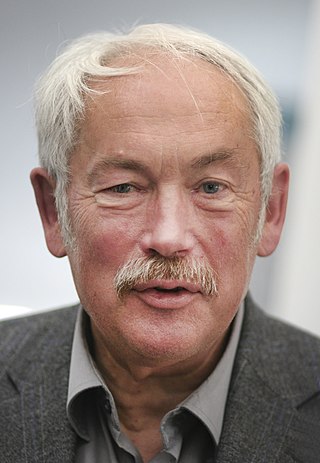
Peter Andreas Grünberg was a German physicist, and Nobel Prize in Physics laureate for his discovery with Albert Fert of giant magnetoresistance which brought about a breakthrough in gigabyte hard disk drives.
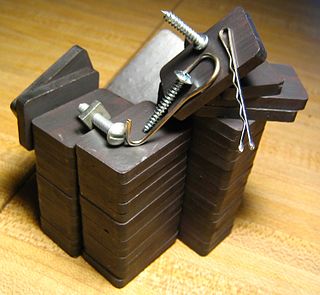
A ferrite is an iron oxide-containing magnetic ceramic material. They are ferrimagnetic, meaning they are attracted by magnetic fields and can be magnetized to become permanent magnets. Unlike many ferromagnetic materials, most ferrites are not electrically conductive, making them useful in applications like magnetic cores for transformers to suppress eddy currents.
Multiferroics are defined as materials that exhibit more than one of the primary ferroic properties in the same phase:
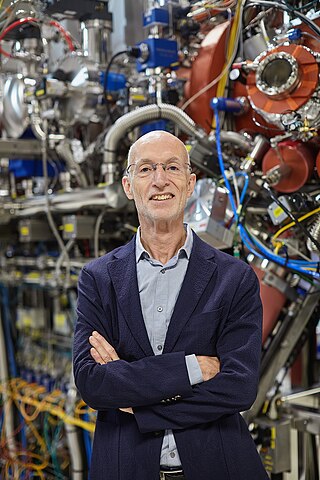
Stuart Stephen Papworth Parkin is an experimental physicist, Managing Director at the Max Planck Institute of Microstructure Physics in Halle and an Alexander von Humboldt Professor at the Institute of Physics of the Martin-Luther-University Halle-Wittenberg.

A mechanical filter is a signal processing filter usually used in place of an electronic filter at radio frequencies. Its purpose is the same as that of a normal electronic filter: to pass a range of signal frequencies, but to block others. The filter acts on mechanical vibrations which are the analogue of the electrical signal. At the input and output of the filter, transducers convert the electrical signal into, and then back from, these mechanical vibrations.
In its most general form, the magnetoelectric effect (ME) denotes any coupling between the magnetic and the electric properties of a material. The first example of such an effect was described by Wilhelm Röntgen in 1888, who found that a dielectric material moving through an electric field would become magnetized. A material where such a coupling is intrinsically present is called a magnetoelectric.
Magnonics is an emerging field of modern magnetism, which can be considered a sub-field of modern solid state physics. Magnonics combines the study of waves and magnetism. Its main aim is to investigate the behaviour of spin waves in nano-structure elements. In essence, spin waves are a propagating re-ordering of the magnetisation in a material and arise from the precession of magnetic moments. Magnetic moments arise from the orbital and spin moments of the electron, most often it is this spin moment that contributes to the net magnetic moment.
Science & Technology Australia (STA), formerly known as the Federation of Australian Scientific and Technological Societies (FASTS), is an organisation representing the interests of more than 90,000 Australian scientists and technologists, and promoting their views on a wide range of policy issues to the Australian Government, Australian industry, and the Australian community.
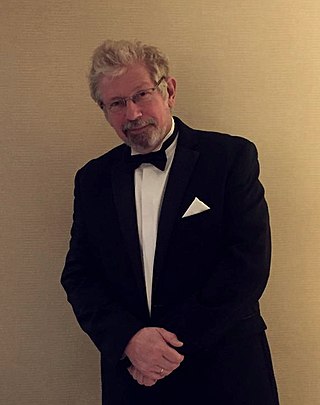
Alexandre Bouzdine (Buzdin) (in Russian - Александр Иванович Буздин; born March 16, 1954) is a French and Russian theoretical physicist in the field of superconductivity and condensed matter physics. He was awarded the Holweck Medal in physics in 2013 and obtained the Gay-Lussac Humboldt Prize in 2019 for his theoretical contributions in the field of coexistence between superconductivity and magnetism.
Superparamagnetic relaxometry (SPMR) is a technology combining the use of sensitive magnetic sensors and the superparamagnetic properties of magnetite nanoparticles (NP). For NP of a sufficiently small size, on the order of tens of nanometers (nm), the NP exhibit paramagnetic properties, i.e., they have little or no magnetic moment. When they are exposed to a small external magnetic field, on the order of a few millitesla (mT), the NP align with that field and exhibit ferromagnetic properties with large magnetic moments. Following removal of the magnetizing field, the NP slowly become thermalized, decaying with a distinct time constant from the ferromagnetic state back to the paramagnetic state. This time constant depends strongly upon the NP diameter and whether they are unbound or bound to an external surface such as a cell. Measurement of this decaying magnetic field is typically done by superconducting quantum interference detectors (SQUIDs). The magnitude of the field during the decay process determines the magnetic moment of the NPs in the source. A spatial contour map of the field distribution determines the location of the source in three dimensions as well as the magnetic moment.

Julia Mundy is an American experimental condensed matter physicist. She was awarded the 2019 George E. Valley Jr. Prize by the American Physical Society (APS) for "the pico-engineering and synthesis of the first room-temperature magnetoelectric multi-ferroic material." This prize recognizes an "individual in the early stages of his or her career for an outstanding scientific contribution to physics that is deemed to have significant potential for a dramatic impact on the field." She is an assistant professor of physics at Harvard University in Cambridge, Massachusetts.
Elisabeth (Beth) Gwinn is a professor in the Department of Physics at the University of California, Santa Barbara (UCSB). Gwinn was the first woman to join the Physics faculty at UCSB. Gwinn's research team explores topics at the intersection of nanoscience, biology, and optics. She is particularly well known for her work on silver nanoclusters and bimolecular-stabilized derivatives thereof. Gwinn is a prominent advocate for boosting diverse representation in the field of physics. She has been an advocate for increasing accessibility to STEM careers more generally through mentorship opportunities for public school students in the United States at the elementary and high-school levels.
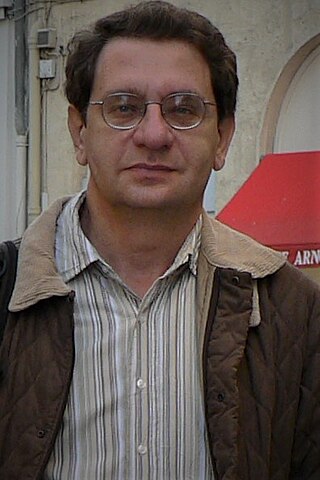
Yuriy Reznikov was a Ukrainian physicist, Head of the Department of Crystals at NASU Institute of Physics and a world-renown expert in the field of liquid crystals. He is known for his work on photoalignment, "giant" optical non-linearity of liquid crystals and nano-colloids.

Simon John Bending, is a British physicist. He is a professor in the Department of Physics at the University of Bath, where he was the Head of department from 2013 to 2016. He is co-director of the Bath-Exeter Centre for Graphene Science and deputy director of the Bath-Bristol EPRSC Centre for Doctoral Training in Condensed Matter Physics. He developed scanning Hall probe microscopy and has made notable contributions to the field of superconductors.

Jeremy Levy is an American physicist who is a Distinguished Professor of Physics at the University of Pittsburgh.
Corundum is the name for a structure prototype in inorganic solids, derived from the namesake polymorph of aluminum oxide (α-Al2O3). Other compounds, especially among the inorganic solids, exist in corundum structure, either in ambient or other conditions. Corundum structures are associated with metal-insulator transition, ferroelectricity, polar magnetism, and magnetoelectric effects.

Sara A. Webb is an astrophysicist, science communicator and author. She is a Superstar of STEM 2023 at Swinburne University, Australia. Her work has won numerous awards.
Tara Pukala or Tara Louise Pukala is a professor of biological chemistry at the University of Adelaide, board member of Nature Scientific Reports, Superstar of STEM, 2023–2024, and Director of the Adelaide Proteomics Centre.
References
- ↑ rrdg331 (2022-11-18). "Newcastle physicist Dr Karen Livesey named a national STEM Superstar". The University of Newcastle, Australia. Retrieved 2024-05-25.
{{cite web}}: CS1 maint: numeric names: authors list (link) - ↑ "API" (PDF).
- 1 2 "Karen Livesey". The Conversation. 2023-06-24. Retrieved 2024-05-25.
- ↑ "Karen L Livesey". www.wikidata.org. Retrieved 2024-05-25.
- ↑ "Karen Livesey". scholar.google.com. Retrieved 2024-05-25.
- ↑ Livesey, K. L.; Ruta, S.; Anderson, N. R.; Baldomir, D.; Chantrell, R. W.; Serantes, D. (2018-07-24). "Beyond the blocking model to fit nanoparticle ZFC/FC magnetisation curves". Scientific Reports. 8 (1): 11166. doi:10.1038/s41598-018-29501-8. ISSN 2045-2322.
- ↑ Livesey, K. L.; Stamps, R. L. (2010-03-05). "High-frequency susceptibility of a weak ferromagnet with magnetostrictive magnetoelectric coupling: Using heterostructures to tailor electromagnon frequencies". Physical Review B. 81 (9): 094405. doi:10.1103/PhysRevB.81.094405.
- ↑ "UCCS".
- ↑ aeo614 (2024-02-27). "National University Teaching Awards celebrate outstanding educators at the University of Newcastle". The University of Newcastle, Australia. Retrieved 2024-05-25.
{{cite web}}: CS1 maint: numeric names: authors list (link) - ↑ "Karen Livesey (Newcastle) is a Superstar of STEM | ARC Centre of Excellence in Future Low-Energy Electronics Technologies". 2022-11-18. Retrieved 2024-05-25.
- ↑ "Associate Professor Karen Livesey". Science and Technology Australia. Retrieved 2024-05-25.
- ↑ "UCCS".
- ↑ "Distinguished referees". EPL. Retrieved 2024-05-25.